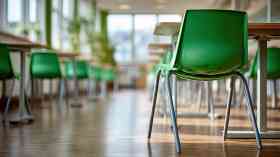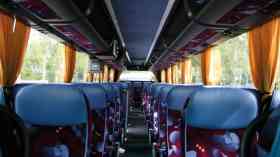Better schools, better learning
 School buildings are used to not only accommodate, but also facilitate teaching and learning, and children spend a large proportion of their formative years within them. Environmental factors such as building age, heating, lighting, air quality, noise, use of colour, type of furnishings, room layout and density have all been associated with significant, measurable changes in student attainment and performance and in influencing student morale, values, aspirations and expectations.
School buildings are used to not only accommodate, but also facilitate teaching and learning, and children spend a large proportion of their formative years within them. Environmental factors such as building age, heating, lighting, air quality, noise, use of colour, type of furnishings, room layout and density have all been associated with significant, measurable changes in student attainment and performance and in influencing student morale, values, aspirations and expectations.
Where the buildings support teaching and encourage learning, it may be hypothesised that teaching becomes easier and teachers derive more job satisfaction. It is therefore crucial that school buildings are designed with the needs of their occupants – both students and teachers – in mind.
Human factors
Ergonomics is frequently termed ‘human factors’. In the design of work places (and schools may be defined as the work place of both pupils and teachers), it aims to put people first, to design tasks, information and the environment to suit the needs and capabilities of each worker – based also on an understanding of the physical and psychological characteristics.
Here we are not concerned about the design of teaching and learning material, the tasks, the organisational structure and social environment, such as teamwork or supportive management, but on the design of the physical environment (temperature, humidity, lighting and noise). This article is based on the latest research conducted by the author and other internationally-accredited researchers. It shows conclusively that all manner of environmental factors effect behaviour and school performance.
Design of school buildings
The appearance of the school and the statement it makes when it is approached makes an immediate impression. Does the school invite children and visitors? Is it a place of welcome? Or are its structures intimidating? Many secondary schools in the UK are featureless and surrounded by security fencing. They are neither inviting nor welcoming. The entrance sets the tone of the conversation its occupants and visitors will have with the school. For example in many schools, the vestibules are too small for parents to have relaxed conversations, or to wait with their other children to see teachers. Clean, well maintained school facilities play an important role in the teaching and learning process.
Children learn to respect their school environment, especially when they see their ideas implemented. All schools should be scaled to the size of their occupants. The transition from home to nursery and primary school, where children are left alone, away from the security of the family, represents a major developmental stage for children, who not only have to associate with unfamiliar children and adults, but learn to be away from the safety and security of their family.
This transition is made easier if the schools are located near to the home and their size is not too large. Child-sized spaces for child-sized children enable them to relax, to listen and to have fun. Equally important is the need for a personal space, perhaps the same chair or position on the carpet for reading where the children can have a sense of belonging.
Smaller schools have been linked with higher attendance rates and graduation percentages, greater participation in extracurricular activities, fewer social and behavioural problems, decreased vandalism, a more effective learning environment, increases in student self-esteem, personal responsibility and leadership qualities.
The performance of students attending small schools has been recorded as between 11 per cent and 34 per cent higher when compared to children in overcrowded schools; 15 per cent higher in mathematics scores and 4 per cent to 9 per cent higher points in reading scores. Children in larger schools cannot achieve sufficient levels of privacy and are over stimulated.
Outside the classroom
Public areas where socialising can take place are often not given sufficient attention. They provide opportunities for children to gather, exchange views and share ideas, and to relax perhaps away from the gaze of others. Well-designed outdoor areas that naturally blend with the school’s functions and form, give the children a sense of being in a natural setting and not in an institution. They provide opportunities to enrich student experience, bring the learning out of the classroom and provide play opportunities for the acquisition of social, cognitive and physical skills.
Sports and recreation areas help develop muscles and bones, increase motor coordination, eye-hand coordination and have a positive effect on processing skills such as decision-making, attention and planning which can improve academic performance. In the US, educational attainment scores were much lower in junior schools where outdoor spaces were poorly designed. Additionally, views out of windows provide visual relief and keep children in touch with the outside world.
Lighting and colour
Natural or daylight is one of the most important environmental inputs, especially in terms of visual development. Variations in the quality of light can have profound influences on the body and mind, for instance by providing visual relief, improving health, reducing vandalism and mental fatigue.
In daylit schools where students are exposed to full spectrum light, attendance levels are raised by just over three days a year, noise levels are lower and student progressions can be up to 20 per cent faster. Whilst such figures must be treated with some sceptism, because of the influence of other factors, most researchers concur. In one such study, 21,000 students were compared, with those attending daylit schools scoring 20 per cent better on mathematics and 26 per cent on reading.
On the contrary, inappropriate lighting can cause eyestrain, blurred vision, negative visual development and headaches, and can affect mental concentration and learning. A balance between full spectrum fluorescent, cool white fluorescent and natural lighting can improve student behaviour as it affects mental attitude, attendance and performance and is a crucial factor in learning.
Colour carries associative and symbolic effects. In relation to educational environments, studies have shown that neutral tints in class relieve eye fatigue and that changes in colour schemes affect academic performance and IQ scores, and can reduce absenteeism. Additionally, teachers comment that children exposed to highly-coloured environments become more hyperactive and harder to manage during the day.
Class density and size
Increases in class density or overcrowding have been associated with behavioural problems, aggression, social withdrawal, dissatisfaction and stress, resulting in less time spent in group involvement and more time in solitary play. It has also been noted that students lose motivation to pay attention or complete a task in high density classes.
Children in smaller groups score higher in all standard achievement tests, especially for reading and maths. Reducing classroom size from 30 students to 20, yields a 6 per cent increase and reducing classroom size from 20 to 10 students resulted in a 13 per cent points increase in achievement scores.
Classroom furnishings
A comfortable classroom greatly impacts learning, productivity and creativity. Research indicates school children complain of high rates of discomfort in the back and neck causing a source of distraction and interfering with their ability to learn and function. Furniture design should accommodate free movements for all sizes but discourage unnatural extreme postures.
Soft classrooms are characterised by warm colours, soft furniture and textured floor coverings and have been shown to encourage better attendance, greater participation and improved attitudes towards the class, instructor and peers.
Even minor changes to class arrangements may produce increased engagement with instructional materials.
Seating and layout
The change from traditional row seating to the use of cluster arrangements typical of cooperative learning may lead to superior academic achievement, better attendance, motivation, self confidence, and greater student interaction. However, in some cases, the row formation is more supportive of learning-related behaviours. Students sitting in the front row and centre of the classroom (known as the action zone) have higher achievement, levels of verbal interaction and participation, with course grades dropping at the rear and sides of classrooms.
Open classrooms lead to increased interaction among teachers, creating a greater sense of autonomy, satisfaction and ambition. In an open, self-contained classroom students were noted to be more independent, and self-directed.
Studies also indicate that within the open classroom it is necessary to arrange for individualised instruction with group contingencies and that there can be an increase in academic production, positive social behaviour and interaction with students in smaller, more intimate group clusters.
Acoustics
Students spend 45 per cent of their time listening. Poor acoustics is a concern for both students and teachers. Where the sound quality in the classrooms is poor, teachers have to shout to make themselves heard (increasing their stress and ill health), and children may not hear what is being said.
Exposure to noise has been found to effect reading, memory, concentration, thinking, listening, behaviour and distracts from visual tasks such as teacher instruction. It creates distraction, dissatisfaction, stress, lack of persistence in task completion, high blood pressure and “learned helplessness”. It also lowers performance and decreases motivation.
A Californian study found 3rd grade students in noisy buildings were 0.4 years behind in reading and 0.2 years behind in maths, while 6th grade students were 0.7 years behind in reading.
Internal noise of combined talking, desks and chairs sliding and papers shuffling is detrimental to learning as it leads to a constant state of aggravation, restlessness, and increased movement. Without a good acoustic environment, learning activities can be severely hindered, particularly where children have to work in a second language.
Temperature and air quality
Although the optimum temperature for classrooms is still being debated, an effective temperature range is considered to be between 62-73F in terms of work performance, with a relative humidity of 50 per cent and good air circulation. Students working in non-air conditioned rooms tend to perform more poorly (3-12 per cent) than their counterparts in air conditioned rooms.
The US Environmental Protection Agency estimates 10 million days lost each year by students due to asthma attacks caused by high counts of settled dust and fibre. Poor air quality causes respiratory infections, aggravates allergies, and causes drowsiness and shorter attention spans. These can all lead to absenteeism, or a feeling of being unwell, and all in turn contribute to poor learning. The ability to open windows for fresh air is an important factor for students.
Tailored environments
The ergonomics of school environments is a relatively new field. Treating the classroom as a work environment, with the attention centred on children, enables the environmental effects on student performance to be studied. The research cited here clearly shows the influence of environmental factors on children.
As alluded to in the introduction, this is just one set of factors that need to be considered. As more is discovered about individual learning styles and the ways in which environments can be tailored to individual requirements, educational facilities should be built that will enable every child to achieve their full potential.
For more information
www.coventry.ac.uk
Latest News
30/10/2025 - 01:28
In the wake of the Raac crisis, the DfE spent £5 million on research into the condition of school buildings, which is due to conclude in spring 2026.
30/10/2025 - 01:09
Malmesbury Primary School in Wiltshire has submitted plans for a major expansion, funded by entrepreneur James Dyson.
30/10/2025 - 00:55
Monday's Every Pair Tells a Story campaign to protest to highlight the national crisis in SEND provision.
29/10/2025 - 09:19
Estimated data from the Department for Education reveals that 470,000 pupils under 16s use local authority funded transport to get to school.
28/10/2025 - 09:29
Timeline set for removal of Reinforced Autoclaved Aerated Concrete







